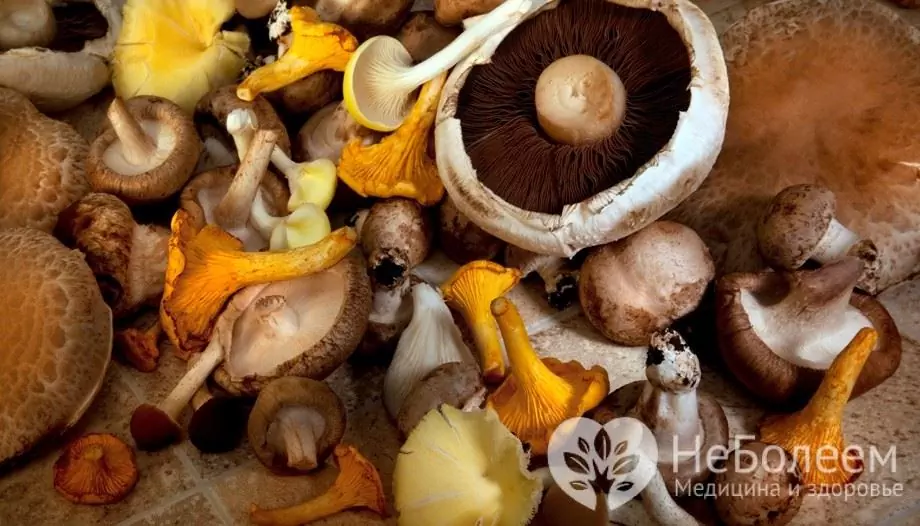- Author Rachel Wainwright [email protected].
- Public 2023-12-15 07:39.
- Last modified 2025-11-02 20:14.
Mushroom poisoning
Mushroom poisoning is usually severe and can often be fatal. Often people cannot distinguish edible mushrooms from conditionally edible or poisonous mushrooms, the result of which can lead to poisoning.

Source: depositphotos.com
How does mushroom poisoning happen?
Biologists have described over 3,000 species of various fungi. Of these, only 400 species are edible, all the rest pose a serious health hazard. Several species are constantly poisonous, and all the rest become poisonous when eaten raw or improperly cooked, and therefore they are called conditionally edible.
The most severe poisoning can cause pale, white and spring toadstools. If you accidentally eat just one quarter of their cap, severe poisoning occurs, which can lead to the death of an adult. Toadstools are dangerous in any form, since the poison amanitin contained in them does not lose its toxicity either when dried or when exposed to high temperatures.
Muscarine, which is found in fly agarics and a whitish talker, is also very dangerous for humans.
In addition to these, the following types of fungi cause severe poisoning:
- smelly mushroom;
- pig;
- false mushrooms;
- parterre mushroom;
- satanic mushroom.
Incorrect cooking technology can cause poisoning with waves, morels, stitches and milk mushrooms.
Symptoms of mushroom poisoning
The first signs of mushroom poisoning usually appear several hours after they are eaten. The duration of the latent period depends on the type of poisonous mushrooms, their number, age, body weight, alcohol consumption and other reasons. For example, in case of pale toadstool poisoning, the incubation period can last up to 6-7 hours, and when eating lepiot or cobweb, it lengthens to several weeks.
When poisoning with mushrooms, regardless of their type, there are some general symptoms that are similar to signs of other foodborne toxicoinfections. These include:
- cramping abdominal pain;
- nausea;
- vomiting;
- diarrhea.
In addition, there are signs that are characteristic of mushroom poisoning.
When poisoning with pale toadstool, diarrhea and vomiting are profuse, they can occur up to 30 times per day. Due to disturbances in the hemostasis system, blood is often present in the feces, and the vomit takes the form of coffee grounds. The victims develop convulsions, increasing cardiovascular and respiratory failure. The functions of the kidneys and liver suffer, up to the development of renal and hepatic failure, which is the cause of a coma, and subsequently death of patients.
For poisoning with talkers and fly agarics, in addition to general symptoms, the following symptoms are characteristic:
- lacrimation;
- increased salivation;
- constriction of the pupils;
- excessive sweating;
- bronchospasm, accompanied by shortness of breath;
- bradycardia;
- hypotension;
- convulsions;
- delusions and hallucinations;
- coma.
In case of poisoning with a panther fly agaric: dilated pupils, tachycardia, dry skin and mucous membranes.
For poisoning with morels and lines, the presence of a convulsive syndrome, the development of toxic hepatitis, lesions of the spleen and kidneys are characteristic. In the blood of patients, the erythrocyte membranes are destroyed (hemolysis), as a result, the urine becomes red.
The symptoms of mushroom poisoning in children are more pronounced, since the child's body is more sensitive to the effects of toxins.

Source: depositphotos.com
First aid for poisoning
The appearance of signs of mushroom poisoning is the basis for the immediate provision of first aid to a poisoned person.
- Rinse the stomach thoroughly. To do this, the patient should be given at least one liter of water to drink, and then, pressing on the root of the tongue, induce vomiting. Repeat this procedure several times until clean wash water. This will help to completely cleanse the stomach of mushroom toxins that have entered it.
- If mushroom poisoning occurs without diarrhea, then the victim should be given 1 tablespoon of castor oil or petroleum jelly.
- To bind toxic substances that have already entered the small intestine, it is necessary to take any sorbent, for example, Polysorb MP, Smecta or Activated Carbon.
- Put the patient to bed, wrap up warmly, put a heating pad on the legs.
- Provide plenty of fluids. You can give strong black tea, mineral or plain water without gas.
When is medical attention required?
In case of any mushroom poisoning, self-medication is unacceptable. If even a slight malaise appears after eating mushrooms, you must urgently call an ambulance or take the victim to the hospital on your own.
Treatment of mushroom poisoning is carried out in toxicological departments. It includes:
- gastric lavage through a thick tube;
- the appointment of a saline laxative;
- carrying out forced diuresis.
In case of poisoning with talkers and fly agarics, the patient is injected with atropine, which is an antidote to muscarine. The dosage of this drug and the frequency of its administration are determined by the doctor.
If necessary, hemosorption is carried out using a carbon column.
In addition, therapy is carried out aimed at eliminating damage to the liver, kidneys, nervous and other systems.
Possible consequences
The consequences of mushroom poisoning, especially if the patient does not see a doctor on time, can be very serious. So, mortality in case of poisoning with pale toadstool occurs in 50-90% of cases. Delayed medical assistance in case of fly agaric poisoning becomes the cause of the death of every second poisoned person.
Severe mushroom poisoning can lead to the formation of chronic liver or kidney failure, which requires transplantation of these organs.
Mushroom poisoning of pregnant women is dangerous, since toxins of inedible fungi can penetrate the uteroplacental barrier and cause damage to the fetus, contribute to spontaneous miscarriage or premature birth.
Prevention
To prevent mushroom poisoning, it is important to observe the following rules:
- only those mushrooms that are well known should be collected;
- do not eat wormy or overripe mushrooms;
- do not taste raw mushrooms;
- collect mushrooms only in the basket;
- do not pick mushrooms growing along roads, near large industrial enterprises, in the protected zone of radiation facilities;
- cook mushrooms as soon as possible after harvesting, their long-term storage is unacceptable;
- when cooking mushrooms, boil them once and drain the resulting broth;
- do not cook any types of canned mushrooms at home;
- being in the forest, do not leave children unattended.
YouTube video related to the article:

Elena Minkina Doctor anesthesiologist-resuscitator About the author
Education: graduated from the Tashkent State Medical Institute, specializing in general medicine in 1991. Repeatedly passed refresher courses.
Work experience: anesthesiologist-resuscitator of the city maternity complex, resuscitator of the hemodialysis department.
The information is generalized and provided for informational purposes only. At the first sign of illness, see your doctor. Self-medication is hazardous to health!






